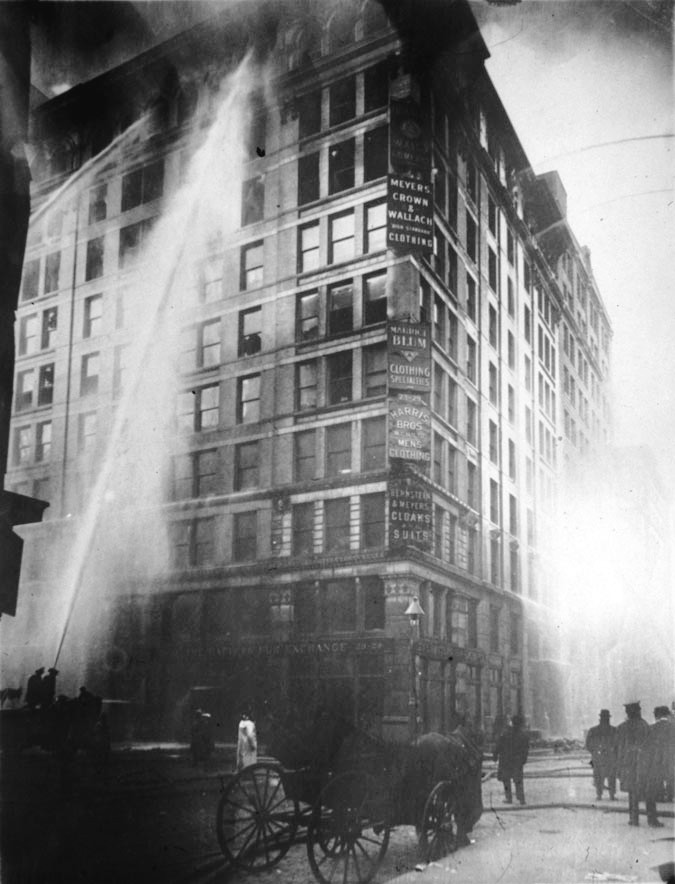It was March 25, 1911, in New York City. It was a Saturday afternoon just like any other at the Triangle Shirtwaist factory, where young immigrant women sat in front of sewing machines, day in and day out, sewing. But on that day a fire broke out, causing the deaths of 146 garment workers. Among those who died in the flames and smoke were 123 women and 23 men.1 Many even jumped or fell to their deaths out the windows, making this event a man-made disaster and one of the deadliest industrial disasters of all time.

The factory was located in the Asch Building at Washington Place in Greenwich Village, one of the wealthiest neighborhoods in the city. The factory occupied the eighth, ninth, and tenth floors of the ten-story building. Max Blanck and Issac Harris were the owners of the factory, and their company was known as the largest firm in the business at the time. They styled women’s blouses known as “Shirtwaists,” which were paired with tailored skirts. This attire had become the standard in fashion for women in the early twentieth century. They were also known to resemble men’s shirts. When it came to their workers, they had hired operators who then contracted out for factory workers. The company itself only dealt with the contractors, and there was no fixed rate of pay for the workers.2 At the time, the factory employed about five-hundred employees, mostly young immigrant women who were of Italian or Jewish descent. These women worked up to eleven-hour shifts on weekdays, and twelve-hour shifts on Saturdays, and they earned between $7-$12 dollars for a 52-hour week. Many of these women were the breadwinners of their household, and their income was sometimes not sufficient to cover their needs.
Towards the end of the workday on that Saturday evening in 1911, a fire broke out around 4:00 pm. The fire started in a scrap bin under one of the cutter’s tables on the eighth floor from what is believed to have come from a cigarette. A manager tried to put the fire out with a hose but the hoses valve was rusted shut, and rotten away. The fire spread quickly and the workers panicked. There was one fire escape that quickly collapsed, and four elevators, which out of the four only one was working. The elevator held twelve people at a time, and it managed to make four rescue trips before it broke down.3 With no other alternatives available, people began throwing themselves out the windows, and some were even crushed to death trying to get out. Workers tried to take the stairs, but the exit doors only opened inward and were kept locked by factory management to prevent theft by the workers, as the managers would check their workers belongings every day before they left for the day.

Celia Saltz Pollack, a survivor of the 1911 Triangle Shirtwaist Fire said,
I remember on that day there was a lot of singing and happiness in the shop because it was the end of the week and we got paid. We were soon all going to go home. When the fire started I was sitting at my machine. I looked up and saw the fire near the cutting tables but I did not think it was so terrible. What was terrible was that the fire spread in a split second.
By the time the firefighters arrived, they came to the realization that their ladders could only extend up to the sixth or seventh floors. With no other option, sixty-two workers jumped and fell to their deaths, while the remaining died from the smoke and flames within the building.4

This fire not only pushed issues of unsafe factories and immigrant exploitation into the public consciousness, but for the first time the fire allowed for attention to be brought to deplorable conditions of New York factories.5 Women obtained well deserved attention onto current work conditions and safety measures in the workplace. Although the Triangle Shirtwaist Factory fire brought a feeling of resentment and heartbreak to many, this event and its victims will always be remembered.
- Ric Burns, “Triangle Shirtwaist Fire,” New York Times (1923-Current File), Nov 24, 1999. ↵
- Jonathan Fink, “Conflagration and Wage: The Triangle Shirtwaist Factory Fire, 1911,” TriQuarterly, no, (2009): 135-136. ↵
- Gale Encyclopedia of U.S. Economic History, s.v. “Triangle Shirtwaist Fire,” by Thomas Carson and Mary Bonk. ↵
- Mia Lynn Mercurio, Régine Randall, “Tributes Beyond Words: Art Educators’ Use of Textiles to Memorialize the Triangle Shirtwaist Factory Fire.” Journal for Learning through the Arts no. 1 (2016): 4-5. ↵
- Albert Marrin, Flesh and blood so cheap: The Triangle fire and its legacy (New York: Alfred A. Knopf, 2011), 23-25. ↵




135 comments
Amanda Cantu
Great article, I remember reading about this awhile back and it was so devastating. The fact that they don’t get paid that much for the countless hours they work is unbelievable. Most importantly how could they even let people work in that building knowing the condition it was in. The elevator broken, the hose rusted and wouldn’t work, the door to the stairs all these conditions scream about a disaster waiting to happen. It so sad that this had to happen for people to notice that the conditions weren’t right. If only they could have realized some work regulations need to be placed so they could have saved the workers lives.
Jasmine Martinez
This was such a tragic incident, that all could’ve potentially been avoided if the company had checked and made sure they were in a safe environment. Sadly, they obviously did not seem to care and let these innocent hard working people lose their life due to the company’s fault. This was a well written article, and it truly opened up the past and how we should be thankful that we have rules and regulations in place to ensure the safety of their workers.
Richard Navarro
I wonder if this particular situation is the reason why there are so many fire exits and extinguishers in buildings now. That sucks that this fire would happen on such a good day, did they ever find the person responsible for this fire? I could only imagine seeing people jump from a ten story building and falling to their death. Not just one person, but 67 in the span of the fire. This is a crazy article, and a very well written one at that. Great work.
Crystalrose Quintero
One of the most common remembrances when hearing about this time in history was the unfortunate fate of those in the burning building who succumbed to jumping out the windows. This was interesting to read about again. But it was sad to read that of the four elevators only one was working. With such a tragic subject it was written with a sympathetic tone that made the article that much more interesting.
Gabriela Serrato
This is such a tragedy and it honestly makes me very sad that so many lives were lost in such a way. It is too hard to even think about the people in this situation, and that so many jumped to their death is terrifying. It angers me that so many could have been saved if the working conditions had been better. I understand that owners are worried for theft, but locking people away is cruel and inhumane. This could have all been prevented if there was better management, and I will always remember the victims.
Matthew Rios
I vaguely remember reading of this once, but it’s a shame to know that so many died completing such a trivial task. The worst part is being that it was mostly women, many mothers weren’t making it home that day. This is why we have laws and regulations regarding the safety of workers now. If anything, owners are most concerned with this now more than ever, because they risk losing so much. Even though the worry nowadays can be out of selfishness, things are better now and that’s great.
Osman Rodriguez
Great article! I think I remember talking about this in high school as a history topic. Terrible event that happened at the time and it was going to sooner or later. The conditions those people worked in and how the owners neglected them, was just terrible. When it comes to incidents like such, I can’t help but speculate, what if the owners themselves started the fire. If I recall correctly, one of the quotes taken from a survivor did say that they were getting paid that day. Of course I hope that wasn’t the case, but it does make you speculate.
Michelle Falcon
I have never heard about this terrible disaster before, to read it was heart breaking. To think of how many people were lost and the families that were left behind, I can’t even image. Of course it is a great thing to learn from the past that that history may not repeat it self, but still sad to think of all the lives lost for us to learn. In the end this was a great article and a great way keep those who were lost in our memory.
Aaiyanna Johnson
This was such a gripping yet, tragic and heart-breaking event. In their efforts of survival, they still coming up short-handed. They were just trying to make a decent living, and something very unfortunate happened. It is outrageous of how a cigarette could cause such a disaster. It is a tragedy that it would take such an occurrence to enforce more concrete safety regulations so tragedies, or unnecessary deaths would occur anymore.
Cameron Ramirez
The Triangle Shirtwaist Factory fire is one of the most well known and deadliest industrial disasters in the early 20th century in United States history. Your article was well written and was very informative. It is so sad that many migrant women lost their lives due to the bosses locking them inside to prevent theft, but that just caused even worse outcomes. Overall, good work on the article and keep up the good work!